
Piedras Blancas Outstanding Natural Area, California Coastal National Monument, Bakersfield Field Office
|
|
ISSUE 913- July 30, 2020
|
|
|
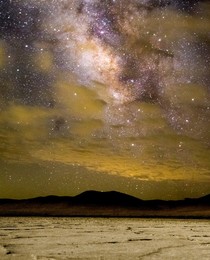
Soda Lake offers amazing view of the galactic core!
Carrizo Plain National Monument is one of the best kept secrets in California. Only a few hours from Los Angeles, the Carrizo Plain offers visitors a rare chance to be alone with nature and view one of the clearest night skies and the galactic core in southern California.
Soda Lake, normally a dry lakebed, is one of the dominant geographic features of the Carrizo Plain. It is the largest remaining natural alkali wetland in southern California and the only closed basin within the coastal mountains. As its name suggests, Soda Lake concentrates salts as water evaporates, leaving white deposits of sulfates and carbonates that look like baking soda. (BLM CA Facebook)
|
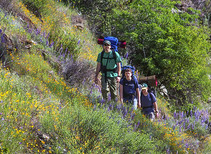
Enjoy #YourPublicLands
Exploration of your public lands is best enjoyed in the company of your family and friends! The North Fork American River lies within a deeply incised canyon with the river itself being 2,000 feet to 2,400 feet below the canyon rim. This segment of the river is a Congressionally-designated Wild River and a State-designated Wild Trout Stream. (BLM Instagram)
|
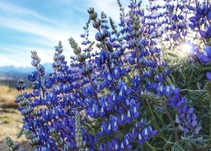
Beautiful California wildflowers
The Lupine is named after “Lupus”, the Latin word for wolf! Although some species of Lupine are poisonous, it is still an important part of a healthy habitat. After a forest fire, Lupine grows rapidly and puts vitamins and nutrients back into the soil which helps the forest grow! It has blue and white flowers with seeds that look like pea pods! (BLM CA Facebook)
|
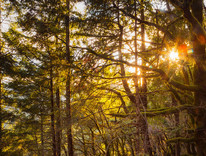
What a beautiful place to spend time outdoors at this Bureau of Land Management California hidden gem
Lacks Creek is a recreational treasure hidden along the coast and offers a wide range of outdoor opportunities. Ride your horse or bike along the shared use trails, or find your own secluded campsite with a view. Lacks Creek is located in California‘s northern Coast Range, approximately 15 miles inland from the Pacific Ocean (BLM CA Facebook)
|
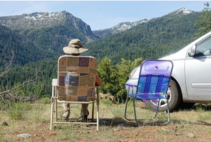
Dispersed camping is perfect for the pandemic
Dispersed camping (boondocking to the RV crowd) typically involves heading down a road (often dirt) on national forest or Bureau of Land Management land and finding a beautiful spot to camp far from organized campgrounds, and usually far from other people. Best of all: it’s legal and almost always free (The Siskiyou Daily News)
|

Don't leave the campfire unattended
Never leave a campfire unattended, even for a few minutes. Some #wildfires start because campers thought their fires were out or because they abandoned them. Adult supervision is always required! #RecreateResponsibly #WildfireSafety (BLM CA Facebook)
|
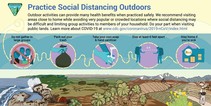
Practice social distancing outdoors
Outdoor activities can provide many health benefits when practiced safely. We recommend visiting areas close to home while avoiding very popular or crowded locations where social distancing may be difficult and limiting group activities to members of your household. Do your part when visiting public lands. (BLM CA Website)
|
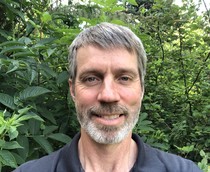
Bureau of Land Management Central California welcomes new District Manager Chris Heppe
Chris Heppe grew up playing in the streams and forests of the Sierra Nevada foothills in Nevada City. It is his love of water, wildlife and their habitat that lead him on a lifelong career in federal service to remote corners of the world. But Heppe’s path has now brought him back home as the new Bureau of Land Management Central California District Manager based in El Dorado Hills. (BLM CA Website)
|
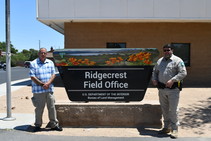
Bureau of Land Management Law Enforcement investigate theft of excavator
Recently, BLM law enforcement, in cooperation with Kern County District Attorney’s Office, investigated an individual responsible for the theft of an excavator belonging to The Friends of Jawbone, a local BLM non-profit partner, who had purchased and were using the Bobcat to assist BLM staff in maintaining public lands. The theft occurred in 2018. (BLM Facebook)
|
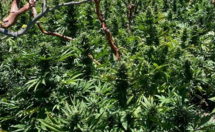
Illegal marijuana cultivations targeted
Over the course of two days, the operation worked to eradicate illegal cultivation sites on over 1000 acres of public and private land. Over 84,000 marijuana plants were eradicated. In addition, 44 pounds of processed marijuana were recovered from a makeshift processing shed. The combination of processed marijuana and future harvest of the eradicated plants has an estimated street value of $42 million. (Riverside Co. Sheriff)
|
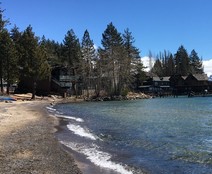
Federal bill could mean huge investment in California National Parks and improved access for communities of color
Congress passed perhaps one of the largest conservation bills in the past 75 years last week. The Great American Outdoors Act, if signed into law, would help prop up national parks and repair deteriorating infrastructure. For areas like Lake Tahoe this could mean upgrades for recreational facilities and more public access to the lake and trails. (Capitol Public Radio)
|
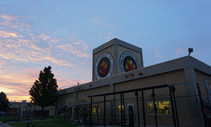
50 years of wildfire support: National Interagency Fire Center celebrates golden anniversary.
Celebrating 50 years of Interagency wildland fire support to the nation. (DOI News Release)
|
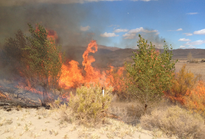
USGS, EROS offer insights to National Fire Strategy discussion
With California burning in the fall of 2018, the conversation came up yet once again. How do we prevent monster fires with names like Camp and Woolsey from torching massive amounts of California landscape—or anywhere else, for that matter? Is it even possible to build fire resistance into the intersection of wildlands and rural developments? (USGS News)
|
 |
|
Drones are illegal to fly near wildfire incidents - they put firefighters, residents & homes at risk
Unauthorized drone flights pose serious risks to firefighter and public safety and the effectiveness of wildfire suppression operations. IF You Fly, We Can't. (USFS)
|
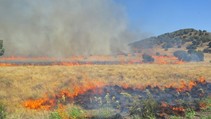
That's not a wildfire, that's a prescribed fire!
Fire managers will use small strips of fire to have low intensity fires on our public lands. Fires help create fresh new grass and protect our waterways from future unplanned fires..(Forest Service Twitter)
|
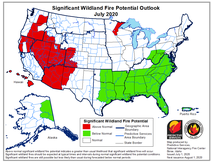
Wildland fire outlook
Check out the latest #WildlandFireOutlook! Available here. (NIFC Facebook)
|
|

The legislation will use royalties from offshore oil and gas drilling to provide up to $1.9 billion a year for five years to repair critical facilities and infrastructure in our national parks, forest, wildlife refuges, recreation areas and American Indian school. It will also permanently fund the Land and Water Conservation Fund to the tune of $900 million a year to invest in conservation and recreation opportunities across the country. (DOI Press Release)
|
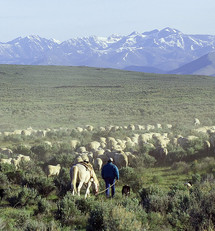
DOI and USDA renew commitment to protect public safety while addressing the threat of predators to livestock and urban-rural communities
The Department of the Interior’s Bureau of Land Management (BLM) and the U.S. Department of Agriculture’s Animal and Plant Health Inspection Service-Wildlife Services (APHIS-WS) today renewed their partnership for alleviating human-wildlife conflicts on BLM-administered public lands. An updated Memorandum of Understanding clarifies respective roles and responsibilities for wildlife damage management and reducing predation on livestock across more than 245 million acres of public lands, mostly in the West and Alaska. (BLM News Release)
|
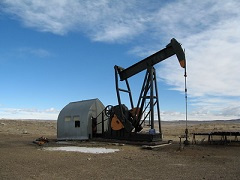
The Trump Administration proposes updates to oil and gas regulations
In support of President Donald J. Trump’s America-First Energy Strategy, the Bureau of Land Management today announced proposed revisions to three key regulations governing oversight of oil and gas production and reporting.op-ed published last week in the Las Vegas Review Journal. (BLM News Release)
|
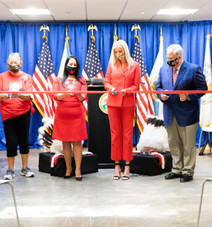
Trump Administration establishes the first Cold Case Task Force Office for Missing and Murdered American Indians and Alaska Natives
U.S. Secretary of the Interior David L. Bernhardt, Senior Advisor to the President Ivanka Trump and Assistant Secretary - Indian Affairs Tara Katuk Sweeney established the first of seven offices dedicated to solving cold cases involving missing and murdered American Indians and Alaska Natives. According to the Federal Bureau of Investigation’s National Crime Information Center, there are more than 1400 unresolved American Indian and Alaska Native missing person cases in the U.S. Of that, 136 cases are in Minnesota. (DOI News Release)
|
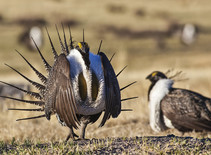
Where do Sage-Grouse build their nests?
1. On a tree limb
2. On the ground
3. Burrowed in a hole
4. Next to a river
Keep scrolling to find the answer.
|
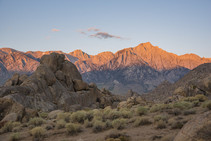
Bureau of Land Management seeks public input on Alabama Hills Management Plan
Public Comment Deadline - 7 August 2020
The BLM is seeking public comment on the Alabama Hills Management Plan by August 7. (BLM CA news release)
|
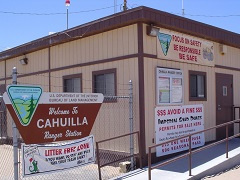
Bureau of Land Management seeks public input on new Cahuilla Ranger Station
Deadline is 31 July 2020
The BLM El Centro Field Office is seeking public input on the proposed replacement of the Cahuilla Ranger Station located at 4500 Gecko Road, Brawley in Imperial County. The new facility would better serve the needs of the public as well as BLM emergency medical staff, law enforcement, and park rangers. (BLM CA news release)
|
|
Question of the Week Answer
The answer is 2! Sage-Grouse build their nests on the ground under sagebrush or grass patches. They cannot survive in areas where sagebrush does not exist! These birds use communal mating grounds called leks, where the males show off their moves and strut their stuff to impress the hens. They can grow to be up to 2 feet tall, are typically 30 inches in length and can have a home range of over 200 square miles. The Sage-Grouse are only found in 11 states in the U.S and two Canadian provinces, their numbers are estimated to be from 200,000 - 500,000 individuals.
Source: Fish & Wildlife Service & Nature Conservancy
|